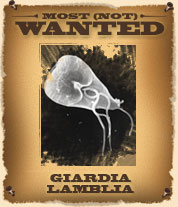
Photo: CDC/ Janice Carr
Name
Giardia lamblia
Also known as
Beaver Fever
Description
- a protozoan master of disguise: may appear as one of two characters
- 1. when active, has been described by witnesses using a microscope as "resembling a clown's face" - an inverted pear shape with two large dark "eyes" (microorganisms) and eight hairlike protrusions (flagella)
- 2. in tougher surroundings, can transform into an egglike cyst in order to survive
(Not) Wanted for
being the most common non-bacterial cause of diarrhoea in North America (giardiasis), and affecting about 200 million people each year around the world, including about 15 to 25% of all children in the developing world.
Modus operandi
- lurks in the environment in cyst form, waiting for a chance to be swallowed accidentally by an unsuspecting victim
- once in a digestive tract, transforms into an active parasite and multiplies, causing such symptoms as diarrhoea, gas, greasy stools that float (but are rarely bloody), and stomach cramps
Most healthy humans can overcome the infection in a few weeks. Giardia is excreted in both active and cyst forms; only the cysts survive outside the host.
Preferred hideouts
- the intestines of many mammals, including humans, cats, dogs, cows, deer, sheep, and beavers
Preferred means of travel
- at first animal faeces, then water, food, soil, and exterior surfaces of animals (including humans)
Area of operation
- the entire globe
Learn about other pathogens on the Most (Not) Wanted list...
Escherichia coli
Salmonella typhi
Campylobacter jejuni
Vibrio cholerae


